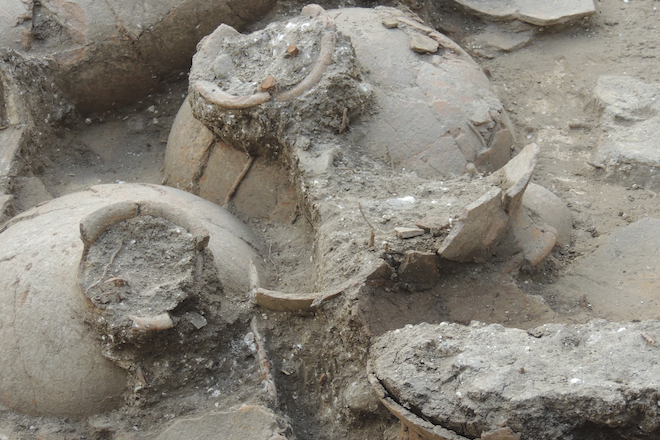
© Eric H. Cline, George Washington University
One of the world's oldest and largest wine cellars has just been unearthed in Israel, according to a presentation today at the annual meeting of the
American Schools of Oriental Research in Baltimore.
The cellar dates to approximately 1700 B.C., and was found at a site called
Tel Kabri within the ruins of a northern Canaanite city. Its age predates both the
Bible and the
Dead Sea Scrolls by hundreds of years.
The researchers christened a three-foot-long jar in the cellar "Bessie."
"We dug and dug, and all of a sudden, Bessie's friends started appearing - five, 10, 15, ultimately 40 jars packed in a 15-by-25-foot storage room," Eric Cline, chair of George Washington University's Department of Classical and Near Eastern Languages and Civilizations, said in a press release.
Cline, who co-directed the project, continued, "This is a hugely significant discovery - it's a wine cellar that, to our knowledge, is largely unmatched in its age and size."
The 40 jars have a capacity of roughly 8453.5 cups, meaning the cellar could have held the equivalent of nearly 3,000 bottles of reds and whites.
"The wine cellar was located near a hall where banquets took place, a place where the Kabri elite and possibly foreign guests consumed goat meat and wine," said the other co-director Yasur-Landau, chair of the Department of Maritime Civilizations at the University of Haifa. "The wine cellar and the banquet hall were destroyed during the same violent event, perhaps an earthquake, which covered them with thick debris of mud bricks and plaster."
Andrew Koh of Brandeis University also worked on the project. Using a technique called organic residue analysis, he studied some of the jar fragments. They yielded traces of tartaric and syringic acids, both key components in wine. Koh also detected other ingredients popular in ancient wine making (and modern day cocktails!), including honey, mint, cinnamon bark, juniper berries and resins.
The Julia Child of wine during those times must have come from ancient Egypt, because the recipe is similar to medicinal
wines that were popular for 2,000 or so years in early Egypt. News of the tasty mixture must have spread to Israel.
"This wasn't moonshine that someone was brewing in their basement, eyeballing the measurements," Koh said. "This wine's recipe was strictly followed in each and every jar."
The researchers hope to recreate the wine, so stay tuned for that, and . . .
Two mysterious doors were found leading out of the wine cellar. They appear to lead to other rooms, but containing what? Maybe more wine? Another dig planned for 2015 should solve the mystery.

Reader Comments
to our Newsletter